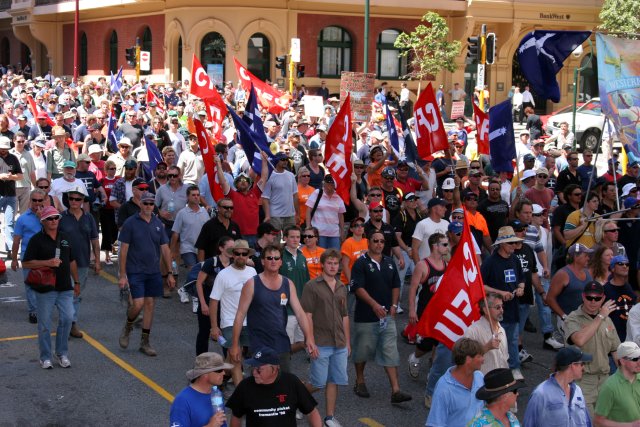
Western Australian Liberal Premier Colin Barnett admitted on August 21 that his government faced a tough start to its second term. This followed fee rises and controversial attacks on the public sector in the August 8 state budget, which provoked a backlash including an August 30 decision by school teachers to plan an industrial campaign.
Public backlash and protest action have forced some partial backdowns by the government. However, the overall thrust of government policy is still fee rises and public sector staff cuts.
On budget day, senior ministers were spinning a line that the state has a debt problem. “Make no mistake, we have a problem with debt,” said treasurer Troy Buswell. Barnett said the government had “no choice” but to raise fees.
This includes higher prices for electricity, water and other utilities of about $235 a year. Other costs include higher car registration fees and a 12.5% rise in land tax alongside a reduction of $4000 for the first home owners grant for people buying established homes. In contrast, first home buyers who purchase a newly built home will receive $3000 more — an indirect subsidy to the construction bosses.
In a sign that the belt tightening is not meant to be evenly spread through the community, corporations were rewarded with a $121 million reduction in payroll tax.
One of the most harmful stings in the budget is a new fee of $4000 a year for each primary or secondary school student whose parents hold 457 visas. A family with five children would be expected to pay $20,000 a year for public education.
This policy comprises three main attacks on workers’ rights. It is an attack on a relatively weak section of the workforce, an attempt to increase the divisions between workers with and without residency rights, and likely a “thin end of the wedge” against the whole population. If a fee of $4000 can be normalised for workers on 457 visas it would be easier to extend that fee to everyone later on.
The policy that attracted the most immediate opposition was a plan to halve the feed-in-tariff for households with rooftop solar systems. A voter backlash and lobbying campaign, and the pressure felt by federal Liberals in marginal seats, led the WA government to back down in four days.
Then on August 14, Barnett announced that he was prepared to back down over his plan to split the City of Vincent in two as part of the government's forced amalgamation policy. This comment came only four days after a 1200-strong protest against the plan.
Amending the boundaries is still not a reversal of the developer-friendly plan to halve the number of local councils in metropolitan Perth. But it is another demonstration that the government is susceptible to popular pressure.
This point was demonstrated again on August 27 when it was reported that the government is considering adjusting the $4000 education fee for children of 457 visa holders. Options being canvassed include means testing or exempting 457 visa holders who are already in the country.
The government is still working on details of an amended scheme. But, once again, there is a tension between the overall “economic rationalist” agenda of the government and the risk to government stability of provoking a more widespread protest movement.
The biggest potential threat to the government's agenda is the trade union movement. The budget also planned to cut 1200 workers from the public service and a further 500 jobs from public education. The government has also announced plans to close schools at a time when WA's population (and student numbers) are rising.
The Civil Service Association (CSA) representing public sector workers held a rally outside parliament on August 6. Militant delegate Janet Parker received a positive response to her call at the rally for a campaign of industrial action to oppose the cuts. The speech by CSA secretary Toni Walkington made clear that the union leadership has no plans for any industrial campaign. There is discontent within the CSA over this lack of a serious response.
By contrast, an August 30 meeting of the State School Teachers Union executive has endorsed a plan for industrial action including a public rally on September 3.
“These cuts [to teacher and education support worker numbers] mean that staff numbers will be decreasing while student numbers will be increasing,” said union president Anne Gisborne in a campaign website announcement.
“You don’t need to be a maths teacher to work out that this will result in bigger class sizes, which will lead to less personal attention for students and poorer learning outcomes.”
United Voice, which represents school staff, has also been campaigning against the staff cuts.
Fremantle councillor and Socialist Alliance candidate for Fremantle Sam Wainwright told Green Left Weekly the partial backdowns by Barnett in the past month showed the government is susceptible to pressure.
He said: “This government can be beaten but we need to ratchet up the momentum if we are to substantially reverse Barnett's cuts. Only a concerted and united industrial campaign by unions combined with protest by the community would have the power to totally stop them in their tracks.”